Urinalysis Instruments and Reagents
Technology advances transform urinalysis
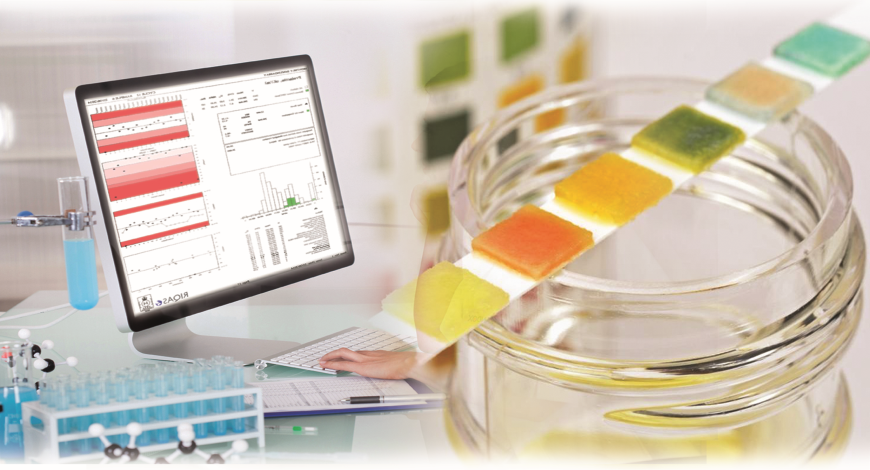
As the healthcare field is developing, new and advanced technologies and techniques are shaping the urinalysis market.
Urinalysis test is a convenient and effective method to detect diabetes, urinary tract infection, and kidney disease. This test is also conducted to identify back pain, painful urination and abdominal pain symptoms. Rising kidney diseases owing to change in food consumption habits accompanied by growing concerns from geriatric population are among major industry drivers. Technological innovation in automated urine sediment analyzers and self-urine strip readers are among key factors to motivate more innovative inventions in urinalysis testing.
Among several test settings, the laboratory based segment is emerging as the leading shareholder in the global urinalysis market. Along with mushrooming private healthcare facilities in both developed and developing economies, the demand for private laboratories is also rising.
Indian market
The Indian market for urinalysis analyzers and reagents in 2018 is estimated at Rs 172.6 crore. Reagents continue to dominate with an 81-percent share, valued at Rs 139 crore. The reagents may be further segmented as 75.5 percent being used by semi-automated instruments, catered to largely by Dirui and Transasia, and also by Roche and Siemens and 24.5 percent by fully automated ones catered to largely by Sysmex, Iris, and Dirui (Rapid).
The overall market has seen an increase in all segments, albeit there is a very slow transition to fully automatic analyzers, which are almost 95 percent placed. The semi-automatic instruments are also now increasingly being placed, with major revenue anticipated from reagents. The urinalysis market continues to be dominated by semi-automated instruments with a 97-percent share, by volume. However, the customers opt for high-throughput instruments.
| Segment | Brand |
|---|---|
| Urine Chemistry | Dirui, Siemens, Roche, and Horiba |
| Urine Sediments | Sysmex, Iris (includes Beckman Coulter), Dirui, Roche, and URIT |
| Integrated Instruments | Iris (includes Beckman Coulter), Sysmex, Dirui, Roche, and URIT |
| Small Players | Mission (Peerless) and Teco Diagnostics |
| Tier I | Tier II | Tier III |
|---|---|---|
| Dirui | Transasia | Roche, Siemens, Agappe, Alere, and DiaSys |
| Segment | Tier I | Tier II |
|---|---|---|
| Reagents for SA | Sysmex, Iris, and Dirui (Rapid) | – |
| Reagents for SA | Dirui and Transasia | Roche and Siemens |
| ADI Media Research | ||
The fully automated analyzers segment is estimated at Rs 15.6 crore, with integrated analyzers seeing maximum growth. The urine sediments fully automated instruments and urine chemistry instruments each contribute about 16 percent to the market, by value. By quantity, urine chemistry instruments have a 28.5 percent share, and urine sediments instrument a 21.43 percent. The integrated fully automated instruments are the most popular with a 50 percent share by quantity, albeit the share by value is 67.3 percent.
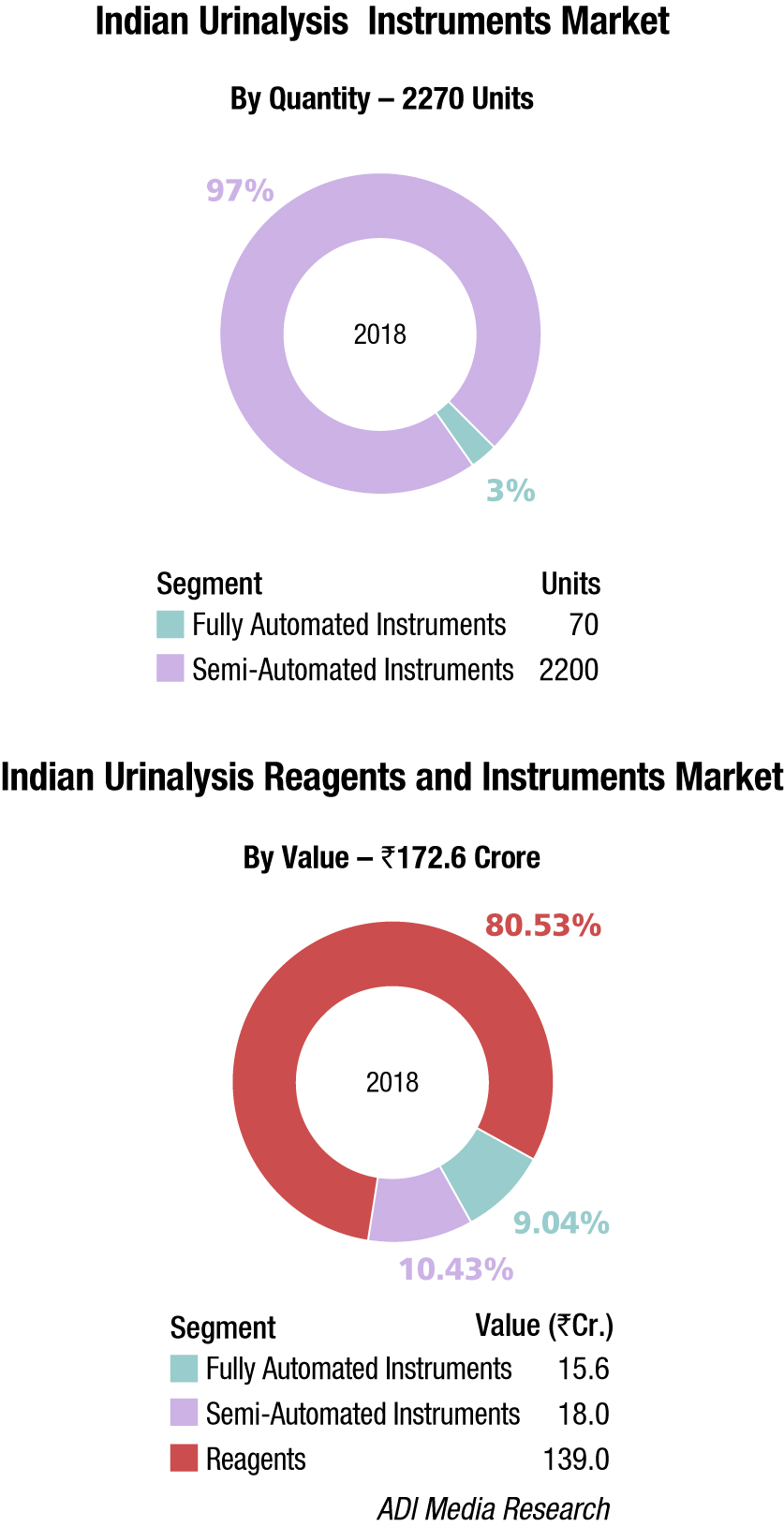 Global Market
Global Market
The global urinalysis market is projected to reach USD 4.6 billion by 2024 from USD 3.2 billion in 2019, at a CAGR of 7.6 percent from 2019 to 2024, forecast MarketsandMarkets. Integrated systems for urinalysis and the emerging economies are expected to provide a wide range of growth opportunities for players in the market which is driven by growing incidences of urinary tract infections (UTIs) and other kidney diseases.
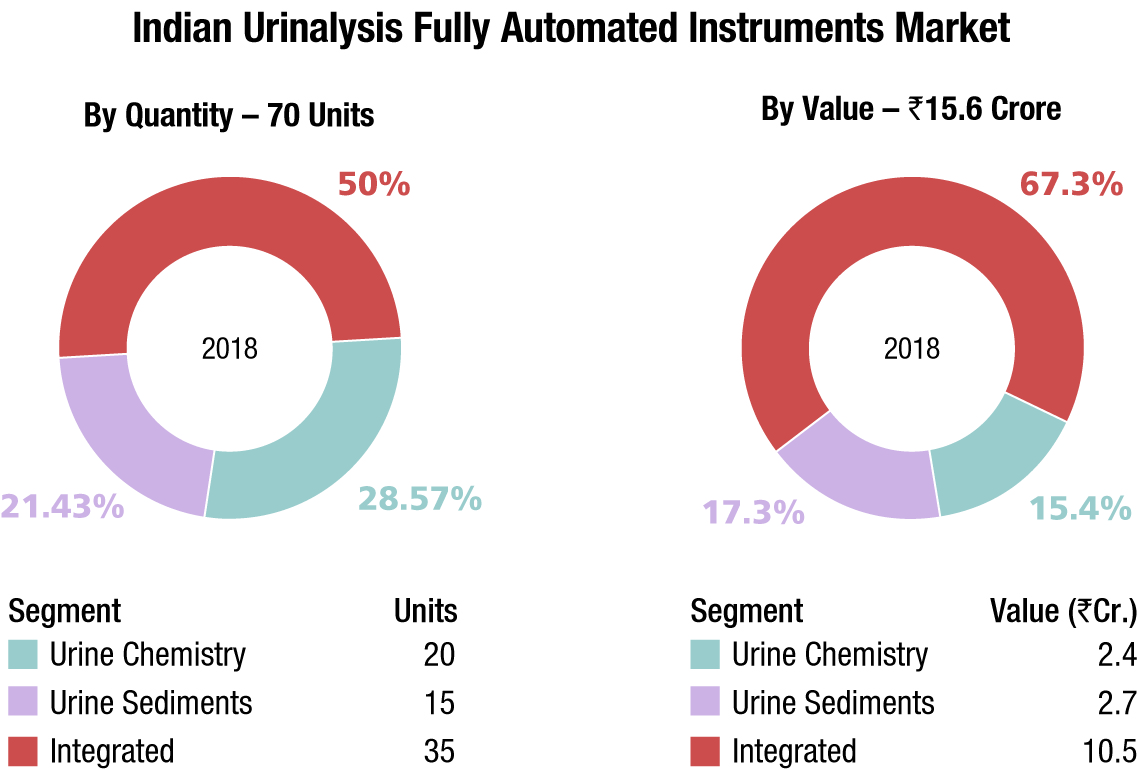
The consumables segment dominated the urinalysis market in 2019. The urinalysis consumables market is segmented into pregnancy & fertility kits, dipsticks, reagents, and disposables. Pregnancy and fertility kits accounted for the largest share of this market in 2019. These kits have witnessed wide adoption amongst end users across the globe owing to their cost-effectiveness and ease of use.
In 2019, the disease screening segment accounted for the largest market share owing to the fact that urine analysis has become a part of the general check-up in hospitals and clinics. Pregnancy and fertility testing is carried out using the kits available in the market either in home care settings or in clinics.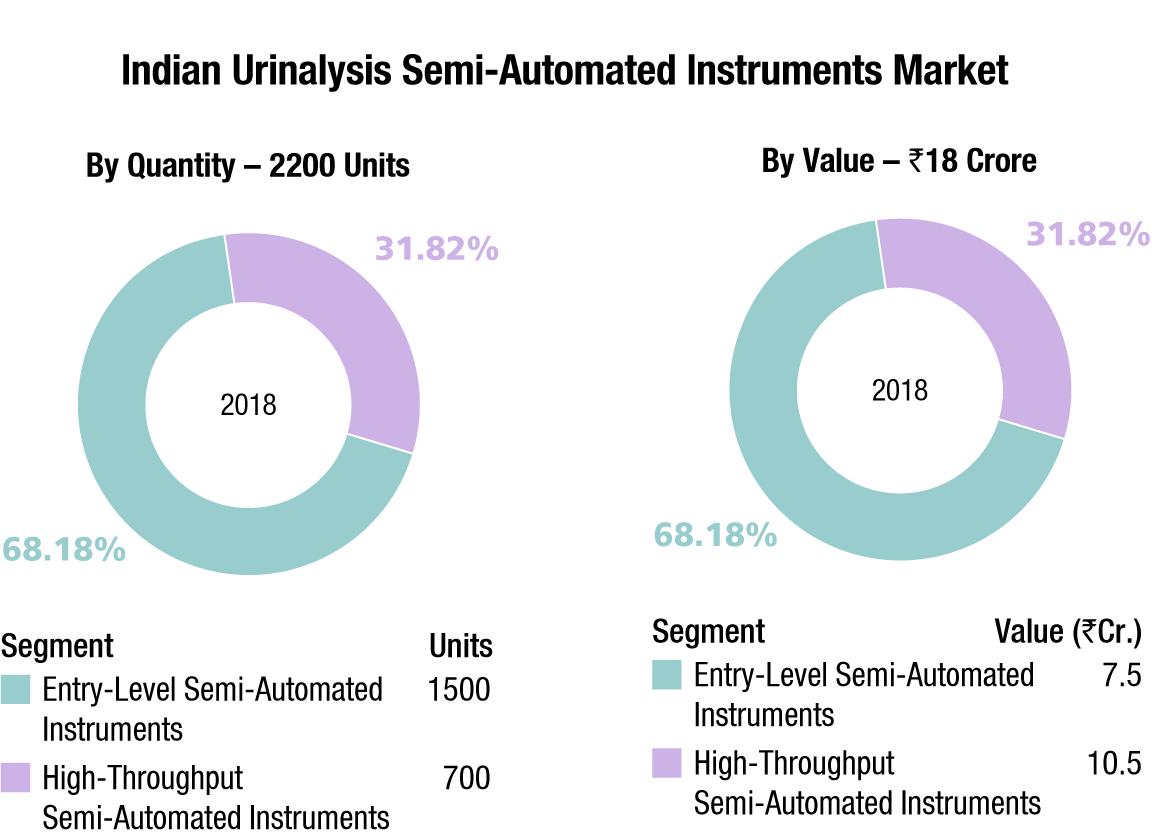
There has been a tremendous increase in the use of urine analysis and has become a part of any general health check up in the past decade. Increasing research activities in the field of urinalysis and growing awareness of personalized medicine have also resulted in the establishment point of care systems. Automated devices have also been installed in the large hospitals and laboratories.
Additionally, lack of availability of the latest diagnostic tools in the developing economies across the globe is significantly hampering market growth. Yet, development of advanced and cost-effective technique to carry out fast and highly precise diagnosis along with easy to use solutions for catering to the unmet clinical needs in the developing as well as underdeveloped economies are estimated to drive market growth in the upcoming years.
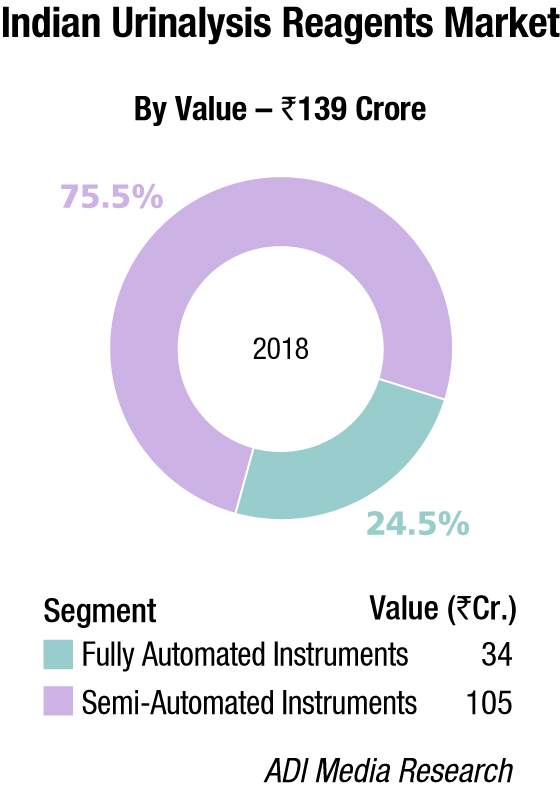
Growing usage of technologically advanced, fast-acting, non-invasive, and easy to use tools for urinalysis are projected to stimulate market expansion of urinalysis industry in the near future. One of the most common applications of the urinalysis is the diagnosis of UTI with the increasing occurrence of hospital-acquired urinary tract infections, especially in females across the globe. The urinalysis is highly efficient and cost effective diagnosis methodology for UTI, thereby driving demand from both developed and developing economies across the globe.
North America has shown major growth in recent years owing to the rise in the implementation of latest technologies in medicine and pharmaceutical sector, development of the automated urine sediment analyzers like digital flow morphology and fluorescence flow cytometry, and existence of well-established infrastructure.
Asia-Pacific region is predicted to hold major market share in the urinalysis industry with massive growth in 2019-2024. India, China, and Singapore are leading the Asia-Pacific market with increasing penetration rate of advanced urine analyzers, rising healthcare expenditure and significant investment by leading industry players considering potential growth opportunities.
The major players in the global market are Roche Diagnostics, Beckman Coulter, Sysmex Corporation, Alere Inc., Bio-Rad Laboratories, Cardinal Health, Arkray Inc., Siemens Healthineers, Elektronika Kft, Dirui, Acon Laboratories, Quidel Corporation, and Urit Medical Electronic.
Technology advances
New technological advances have paved the way for significant progress in automated urinalysis. Quantitative reading of urinary test strips using reflectometry has become possible, while complementary metal oxide semiconductor (CMOS) technology has enhanced analytical sensitivity and shown promise in microalbuminuria testing. Microscopy-based urine particle analysis has greatly progressed over the past decades, enabling high throughput in clinical laboratories. Urinary flow cytometry is an alternative for automated microscopy, and more thorough analysis of flow cytometric data has enabled rapid differentiation of urinary microorganisms. Integration of dilution parameters (e.g., creatinine, specific gravity, and conductivity) in urine test strip readers and urine particle flow cytometers enables correction for urinary dilution, which improves result interpretation. Automated urinalysis can be used for urinary tract screening and for diagnosing and monitoring a broad variety of nephrological and urological conditions; newer applications show promising results for early detection of urothelial cancer.
Concomitantly, the introduction of matrix-assisted laser desorption ionization-time-of-flight mass spectrometry (MALDI-TOF MS) has enabled fast identification of urinary pathogens. Automation and workflow simplification have led to mechanical integration of test strip readers and particle analysis in urinalysis. As the information obtained by urinalysis is complex, the introduction of expert systems may further reduce analytical errors and improve the quality of sediment and test strip analysis. With the introduction of laboratory-on-a-chip approaches and the use of microfluidics, new affordable applications for quantitative urinalysis and readout on cell phones may become available.
Outlook
While there are numerous factors supporting the growth of the global urinalysis market, a few challenges exist as major market restraints. High cost of tests and equipment are a couple of these restraining factors. Such expenses make it difficult for economically unstable people to afford the test procedures. Nonetheless, rising government support and availability of several health insurances are believed to underpin the growth momentum in the global urinalysis market.











